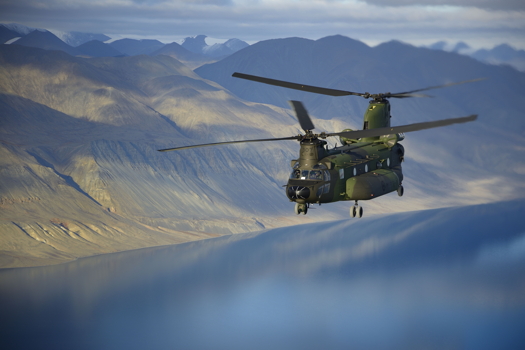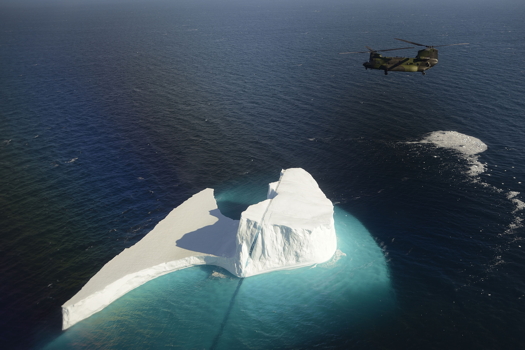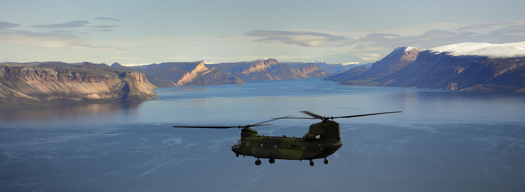
Returning from Canadian Forces Station Alert on August 24, a CH-147F Chinook helicopter flies over Hazen Lake in Ellesmere Island, Nunavut. RCAF/Corporal Arthur Ark Photo
How vast is Canada’s North?
Five Aerospace Engineering Test Establishment (AETE) personnel from 4 Wing Cold Lake, Alberta, flew to Canadian Forces Station (CFS) Alert in August to test navigation systems on two CH-147F Chinook helicopters. Their mission – from Canadian Forces Base (CFB) Petawawa, Ontario, to Alert, Nunavut, and then to Iqaluit, on Baffin Island, Nunavut – spanned more than 8,600 kilometers.
That is slightly farther than the distance from Cold Lake, Alberta, to Lima, Peru. Or to Algiers. Or Tokyo.
The purpose of the project was to evaluate the CH-147F Chinook helicopter in the Northern Domestic Airspace (Arctic) with specific focus on navigation and communication systems. Major Brett Banadyga, one of the test pilots on the mission, said when flying in the Arctic, navigation is based on true north as opposed to magnetic north.
“The main point of concern with the inertial system was its ability to align itself with true north at high latitudes,” Major Banadyga said. “Fortunately, the system performed very well.”
The Royal Canadian Air Force’s (RCAF’s) large transport planes – the CC-130 Hercules and the CC-177 Globemaster – have had inertial navigation systems on board for some time, “but the laser-ring gyroscope inertial navigation system is new to the Chinook,” said Major Banadyga.
The CH-147F Chinook is planned to reach IOC (Initial Operational Capability) in the near future. In proving the integrity of the aircraft’s navigational systems in extreme high latitudes, this testing was a key gateway for the Chinook to operate in Canada’s North.

A CH-147F Chinook helicopter overflies an iceberg in Admiralty Inlet, Baffin Island, Nunavut, on August 15. RCAF/Corporal Arthur Ark Photo
After less than one year in service, the Chinooks being sent to the most remote destination on the continent represents a significant challenge from both sustainment and maintenance points of view – the aircraft could not have been farther from their supply chain and maintenance support. To ensure success and to deal with remote service requirements, the 23-person detachment comprised key maintenance capabilities and spares.
The Chinook represents a transformational capability for the Canadian Armed Forces. With the helicopter’s 600-nautical-mile range and about five hours of endurance, the RCAF’s ability to tactically project land and special operations forces has never been more robust.
AETE personnel on the test mission included two test pilots, a flight test engineer, a systems evaluator, and an image data systems technician. The AETE members joined 17 members of 450 Tactical Helicopter Squadron, from 1 Wing Kingston, Ontario, but based at CFB Petawawa, and one member from 8 Wing Trenton, Ontario.
The two Chinooks flew out of Petawawa with stops in communities in Ontario, Manitoba, and Nunavut en route. “We drew crowds most places we stopped,” Major Banadyga said. “We enjoyed meeting the local people and we gave a lot of tours of the Chinooks.”
Test flights out of Alert took the helicopters as far north as Cape Columbia, on Ellesmere Island, Nunavut, the northernmost point of land in Canada. After the testing was completed, the 450 Squadron personnel and the Chinooks joined Operation Nanook in Iqaluit, and the AETE team returned to Cold Lake.

A CH-147F Chinook helicopter prepares to land at Arctic Bay, Baffin Island, Nunavut. RCAF/Corporal Arthur Ark Photo
Read more about the CH-147F Chinook and watch a video walk-through of the aircraft here.









